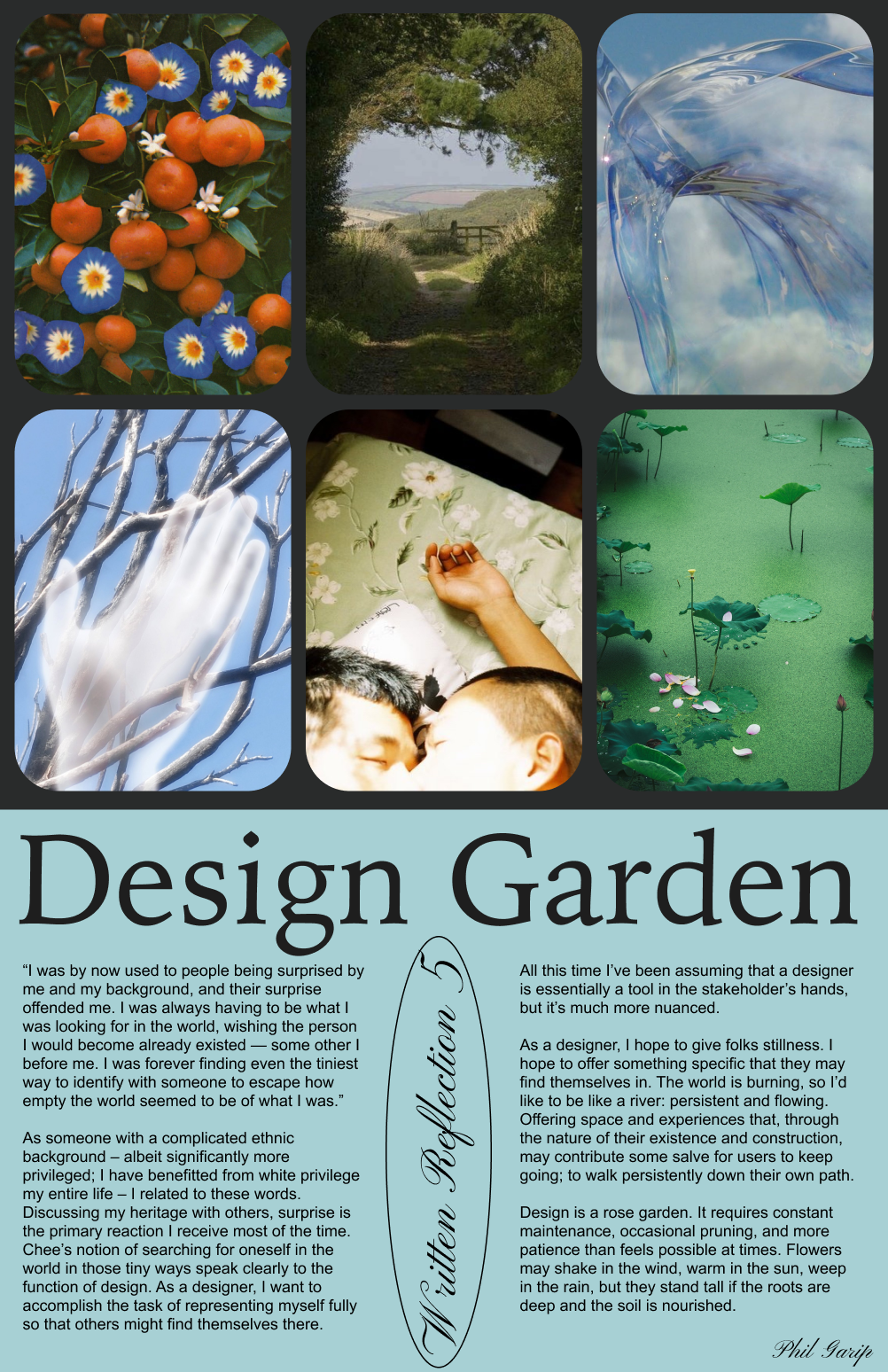Design Garden
This article was produced during my 2023 fall semester at Pratt Institute. We were tasked with articulating our personal design philosophies; the designed asset is below, and the tex contained is at the bottom of the page.


Throughout the duration of the semester, per the request of the professor, I’ve been trying to identify my own ethos as a designer. A long and winding road, I’m still not quite sure I have an answer, but something is slowly emerging from the shadows. Alongside the coursework and the assigned readings, I’ve also been doing my own reading. One book of essays in particular has spoken directly to both my personal and creative sensibilities: How to Write and Autobiographical Novel by Alexander Chee. Both mystic and distinctly fleshy, his writing and his perspective feel closely knit with my own point of view; I really identify with the reverence he has for the world around him, one that he builds softly yet firmly.
This is not a book report, I know, but bear with me.
There is one story, wherein Chee moves into his first apartment in Brooklyn after moving from San Francisco. The apartment is small, a studio, but it has a garden in the back – my dream! – in which he begins to plant roses. I didn’t know this before, but roses are extremely resilient. Thick woody canes support the bushes’ structure, while thick waxy leaves wrap the thorny stems, atop which velvety fragrant blooms appear – if you grow them right. Throughout his essay, Chee details the painful process of cultivating a rose garden. From tilling the soil and laying flagstones to boring holes into the canes to destroy weevils, the exercise of maintaining the bushes became a metaphor for Chee’s own self maintenance.
Design has felt similar to me in some ways. I’ve seen my own energy flag and rebound throughout the semester which has had a 1:1 effect on my design practice. I’ve been wondering if my design practice should be my rose garden. It’s always been true that I treat my creative pursuits like extensions of myself. I used to view this as a weakness, but as I grow older I’m seeing it as a strength. When I am at my best, so are my designs.
One of my favorite photographers, Minor White, said "No matter how slow the film, Spirit always stands still long enough for the photographer It has chosen.” When asked to tackle wellbeing in this class, White’s words echoed in my mind. How can each of us achieve enough stillness to see Spirit standing there? We wanted to address several components of our daily lives that might create barriers for people to find that stillness, while offering helpful tools to that might give perspective on patterns of feeling over time. We were mostly successful, with future directions clear and achievable.
Design can mean so many different things. A good friend of mine, a clothing designer, firmly denies any allegations that he is an artist. The line in the sand for him is the place he holds in the greater timeline of his craft. “I’m not telling stories, I’m contributing to a wider stream of history before me that will continue after I am gone.” I see his point, but as I’ve worked in my own design capacity throughout the semester, I feel it impossible to separate our own stories from the work we do. And I hope I never have to; to me, it is crucial to the field as a whole that the tapestry we are collectively weaving contains threads of all origins.
In another essay discussing his experience as a mixed race Korean-American, Alexander Chee wrote:
“I was by now used to people being surprised by me and my background, and their surprise offended me. I was always having to be what I was looking for in the world, wishing the person I would become already existed — some other I before me. I was forever finding even the tiniest way to identify with someone to escape how empty the world seemed to be of what I was.”
As someone with a complicated ethnic background – albeit significantly more privileged; I have benefitted from white privilege my entire life – I related to these words. Discussing my heritage with others, surprise is the primary reaction I receive most of the time. Chee’s notion of searching for oneself in the world in those tiny ways speak clearly to the function of design. As a designer, I want to accomplish the task of representing myself fully so that others might find themselves there.
All this time I’ve been assuming that a designer is essentially a tool in the stakeholder’s hands, but it’s much more nuanced.
As a designer, I hope to give folks stillness. I hope to offer something specific that they may find themselves in. The world is burning, so I’d like to be like a river: persistent and flowing. Offering space and experiences that, through the nature of their existence and construction, may contribute some salve for users to keep going; to walk persistently down their own path.
Design is a rose garden. It requires constant maintenance, occasional pruning, and more patience than feels possible at times. Flowers may shake in the wind, warm in the sun, weep in the rain, but they stand tall if the roots are deep and the soil is nourished.